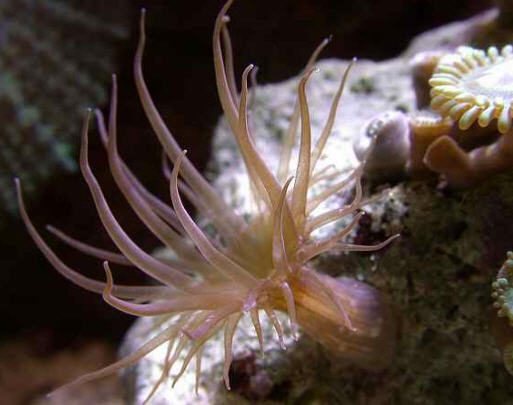As a saltwater fish store in Las Vegas, one of the number one issues people have is high phosphates. Its a chemical that is needed in small quantities in your tank, but poisonous in even slightly larger concentrations. So what are phosphates? What causes them? And how do we get rid of them?
What are phosphates in a reef tank?
Phosphates are chemical compounds that contain the element phosphorus (shocker), which is an essential nutrient for living organisms. In the context of aquariums, including reef aquariums, phosphates play a crucial role in the growth and development of organisms, including corals and other marine life.
While phosphates are necessary for the health of marine life, excessive levels can lead to problems. In a reef tank, elevated phosphate concentrations can fuel the growth of undesirable algae which can compete with corals for resources and compromise the overall aesthetic and health of the aquarium. It can affect ph, water quality, compete for resources with coral, poison fish and even cause bacterial blooms that outcompete beneficial bacteria.
What causes phosphates?
Phosphates primarily come from fish waste, uneaten food, and decaying organic matter. In rarer cases, but not at all uncommon, magnets separating inside the aquarium (algae clip feeder, frag racks) and rust from a screw dripping condensation into the tank can cause excessive phosphates.
But what about when you’re feeding correctly, high quality food and nothing seems to be causing it? We have seen many cases of overzealous significant other is using cleaning sprays, deodorizers or other atomized sprays near the tank cause phosphates. Even scented candles, plug in fresheners and being too close to a kitchen can cause the airborne particles to adjust phosphates. These are usually more common in smaller tanks where water quality is easier to manipulate with small additions of things.

How to get rid of high phosphates in a reef tank?
THIS is what your probably reading this article for. The why isn’t as important as the how when it comes to the health of your tank. There are many options and we will chew threw them.
External Factors
These are things outside of your tank, in your house or around the tank itself. This includes, but isn’t limited to:
- Making sure no magnets are separating. Old magnets from frag racks, algae feeding clips and others can degrade in saltwater. Make sure the seals havent separated and the magnet isn’t in contact with your water
- Make sure all your pumps are working well and arent leaking oil or grease at the seals. Pumps, wavemakers, gyres and other mechanical things in your tank fail. We have seen high phosphates come from leaking pumps and other equipment. Take a close look, oily residue on the surface of the sump or tank is a huge red flag for this.
- Make sure there is no rust in the water or in the sump area. Saltwater rusts everything, even stainless steel eventually. Screws holding your cabinet together, metal hose clamps, even power strips all have metal that will rust in it. Take a close look around the sump and above it. We have seen many times a rusty clamp that has condensation on it that is slowly dripping into the sump.
- Verify that nobody is using aerosols anywhere near your tank, no glass cleaners, no febreeze, no pinesol… cleaning products and anything you spray cannot be near your tank. The smaller the tank, the more sensitive.
- Random other things. Scented candles, being too close to a kitchen, and other things you wouldn’t think of can also affect the water. Be more cautious again the smaller your tank is. Once you hit about 100 gallons things like this really aren’t powerful enough to adjust your water chemistry.
Internal Factors
These are things outside of your tank, in your house or around the tank itself. This includes, but isn’t limited to:
- Making sure no magnets are separating. Old magnets from frag racks, algae feeding clips and others can degrade in saltwater. Make sure the seals havent separated and the magnet isn’t in contact with your water
- Make sure all your pumps are working well and arent leaking oil or grease at the seals. Pumps, wavemakers, gyres and other mechanical things in your tank fail. We have seen high phosphates come from leaking pumps and other equipment. Take a close look, oily residue on the surface of the sump or tank is a huge red flag for this.
- Make sure there is no rust in the water or in the sump area. Saltwater rusts everything, even stainless steel eventually. Screws holding your cabinet together, metal hose clamps, even power strips all have metal that will rust in it. Take a close look around the sump and above it. We have seen many times a rusty clamp that has condensation on it that is slowly dripping into the sump.
- Verify that nobody is using aerosols anywhere near your tank, no glass cleaners, no febreeze, no pinesol… cleaning products and anything you spray cannot be near your tank. The smaller the tank, the more sensitive.
- Random other things. Scented candles, being too close to a kitchen, and other things you wouldn’t think of can also affect the water. Be more cautious again the smaller your tank is. Once you hit about 100 gallons things like this really aren’t powerful enough to adjust your water chemistry.
Food, your most probable cause
These are things outside of your tank, in your house or around the tank itself. This includes, but isn’t limited to:
- Making sure no magnets are separating. Old magnets from frag racks, algae feeding clips and others can degrade in saltwater. Make sure the seals havent separated and the magnet isn’t in contact with your water
- Make sure all your pumps are working well and arent leaking oil or grease at the seals. Pumps, wavemakers, gyres and other mechanical things in your tank fail. We have seen high phosphates come from leaking pumps and other equipment. Take a close look, oily residue on the surface of the sump or tank is a huge red flag for this.
- Make sure there is no rust in the water or in the sump area. Saltwater rusts everything, even stainless steel eventually. Screws holding your cabinet together, metal hose clamps, even power strips all have metal that will rust in it. Take a close look around the sump and above it. We have seen many times a rusty clamp that has condensation on it that is slowly dripping into the sump.
- Verify that nobody is using aerosols anywhere near your tank, no glass cleaners, no febreeze, no pinesol… cleaning products and anything you spray cannot be near your tank. The smaller the tank, the more sensitive.
- Random other things. Scented candles, being too close to a kitchen, and other things you wouldn’t think of can also affect the water. Be more cautious again the smaller your tank is. Once you hit about 100 gallons things like this really aren’t powerful enough to adjust your water chemistry.
Other Solutions
So… you feed quality food, you feed the right amount, nothing weird is going on around your tank… but phosphates are still high? Now what?!? Well maybe you have an overstocked tank, have messy eaters (eels, predator fish, tangs), or some other combo. Here are some of the best solutions for you.
Filters
Filters are under acknowledged heros of reef keeping and one of the easiest ways to adjust nutrients.
- Adjust timing of filter sock changes. Phosphates and nitrates too high? Change it more often, too low? Change them less often.
- Upgrade filter socks. A lower micron filter sock will increase the amount of stuff captured, but again requires more frequent sock changes.
- Longer filter socks. Some sock chambers have room for longer socks, use that room to upgrade your filtration
- Upgrade to a fleece roller. Fleece rollers are like having new socks in your tank every few hours. They drastically reduce nutrients in reef tanks but are an expensive option.
Chemicals
Ahh chemicals, the magic cure in a bottle.
- If high nutrients are an ongoing problem, carbon dosing may be for you. There are homemade recipes RedSea Nopox and dozens of others. But basically its an alcohol and vinegar mixture. This feeds coral that eats phosphates and nitrates. This is an amazing solution but it does require ongoing dosing basically forever. This works though.
- Brightwell Aquatics Phosphate E, Tropic Marin Elim-Phos, Bluelife Phos Rx and others. These are all probably lanthanum chloride. It binds phosphate and removes it instantly from the tank. These aren’t great to use forever but they are amazing for high phos spikes (someone overfed while you were out of town, algae dieoff etc). It will reduce phosphates but it works fast, and nothing fast is good in this hobby. Always dose into your filter sock and start SLOW.
- GFO. This is a broad category and could probably use its own post. But there are dozens of variations of GFO and resins that absorb phosphates. They come in a granulated product you usually put in a bag or a reactor and they absorb phosphates. These do work but there is no sign that they are used up until your phosphates rise. They need a dedicated reactor to be truly effective as well.
Mother Nature
Why try and rewrite the book?
- Refugium. Chateo is a magical algae… it stays clumped in a ball, doesn’t attached to anything and doesn’t spread except to make the ball bigger, oh and it eats phosphates and nitrates. A dedicated refugium is one of the easiest and simplest ways to keep nutrients in check. When you tear pieces of chaeto off and trash it, those nutrients are out of your tank forever.
- Live rock. Live rock eats P04 (phosphates). With the new negative space aesthetic for tanks, and bare bottom tanks… we have less live rock than ever. Rubble in the sump or even more in the main tank goes a long way to raising your tanks ability to process waste
- Algae scrubbers. These are like refugiums in a box. A bright led light is shined over a matrix seeded with algae, it grows algae in there which consumes nutrients and is also exported when you throw the algea away. Another amazing solution.
- Water changes. GASP! what a shocker. Regular water changes reduce all the bad stuff in the water. Increasing frequency or amount is a good way to adjust your nutrient levels.
Honorable Mentions
- Biomedia. Bio balls, Seachem matrix and other live rock replacements help with nutrient exports.
- Biomass, sulphur and DE reactors. These are more exotic setups, they work but are fiddly, expensive and in the sulphur’s case, really stink.
Conclusion
As you can see there are as many causes as solutions for phosphates in a reef tank. The key is patience and perseverance. Finding the source of the phosphates is key to finding the right solution… start there. Then just keep trying until you get a combo that works for you to keep your tank stable. And if you are in Las Vegas you can swing by Artistic Oceans and we would love to help you out!



